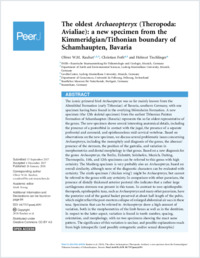The oldest Archaeopteryx (Theropoda: Avialiae): a new specimen from the Kimmeridgian/Tithonian boundary of Schamhaupten, Bavaria
- Rauhut, Oliver W.M. SNSB—Bayerische Staatssammlung f!ur Paläontologie und Geologie, Munich, Germany - Department of Earth and Environmental Sciences, Ludwig-Maximilians University, Munich, Germany - GeoBioCenter, Ludwig-Maximilians University, Munich, Germany
- Foth, Christian Department of Geosciences, Université de Fribourg, Switzerland - Staatliches Museum für Naturkunde, Stuttgart, Germany
- Tischlinger, Helmut Stammham, Germany
-
26.01.2018
Published in:
- PeerJ. - 2018, vol. 6, p. e4191
English
The iconic primeval bird Archaeopteryx was so far mainly known from the Altmühltal Formation (early Tithonian) of Bavaria, southern Germany, with one specimen having been found in the overlying Mörnsheim Formation. A new specimen (the 12th skeletal specimen) from the earliest Tithonian Painten Formation of Schamhaupten (Bavaria) represents the so far oldest representative of the genus. The new specimen shows several interesting anatomical details, including the presence of a postorbital in contact with the jugal, the presence of a separate prefrontal and coronoid, and opisthocoelous mid-cervical vertebrae. Based on observations on the new specimen, we discuss several problematic issues concerning Archaeopteryx, including the monophyly and diagnosis of the genus, the absence/presence of the sternum, the position of the gastralia, and variation in morphometrics and dental morphology in that genus. Based on a new diagnosis for the genus Archaeopteryx, the Berlin, Eichstätt, Solnhofen, Munich, Daiting, Thermopolis, 11th, and 12th specimens can be referred to this genus with high certainty. The Maxberg specimen is very probably also an Archaeopteryx, based on overall similarity, although none of the diagnostic characters can be evaluated with certainty. The ninth specimen (‘chicken wing’) might be Archaeopteryx, but cannot be referred to the genus with any certainty. In comparison with other paravians, the presence of distally thickened anterior pectoral ribs indicates that a rather large cartilagenous sternum was present in this taxon. In contrast to non- opisthopubic theropods, opisthopubic taxa, such as Archaeopteryx and many other paravians, have the posterior end of the gastral basket preserved at about half-length of the pubis, which might reflect the post-mortem collapse of enlarged abdominal air sacs in these taxa. Specimens that can be referred to Archaeopteryx show a high amount of variation, both in the morphometrics of the limb bones as well as in the dentition. In respect to the latter aspect, variation is found in tooth number, spacing, orientation, and morphology, with no two specimens showing the exact same pattern. The significance of this variation is unclear, and possible explanations reach from high intraspecific (and possibly ontogenetic and/or sexual dimorphic) variation to the possibility that the known specimens represent a ‘species flock’ of Archaeopteryx, possibly due to island speciation after the initial dispersal of the genus into the Solnhofen Archipelago.
- Faculty
- Faculté des sciences et de médecine
- Department
- Département de Géosciences
- Language
-
- English
- Classification
- Palaeontology
- License
- License undefined
- Identifiers
-
- RERO DOC 306853
- DOI 10.7717/peerj.4191
- Persistent URL
- https://folia.unifr.ch/unifr/documents/306525
Statistics
Document views: 83
File downloads:
- fot_oat.pdf: 246
